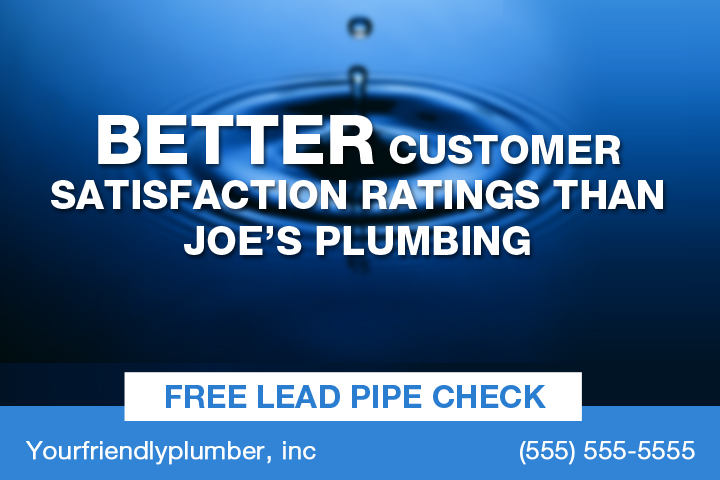I’m sure this article is going to spawn some disagreements. There are many in the ad industry that still use this technique to advertise their clients, but I think it’s cheap and completely lacking in creativity. They use it because it’s effective, it gets people’s attention, and it actually does have the capability of increasing sales. Politicians are the kings of this form of advertising, but unfortunately, that inspires businesses to think they can do the same thing. I’m talking about negative advertising. What exactly is negative advertising?
Your house is killing you
The Problem
Have you ever seen an ad for a company that tells you something like, “Your life will be terrible if you don’t do this thing,” or, “Someday, your [insert product here] is going to explode! Make sure you stay alive.” You tend to find it more often in the service industry. It’s the idea that the ad will remind customers of their frustration with a product/service in hopes of offering a solution to that frustration. Frequently, those ads play on the frustration and fear of something bad that has already happened. The goal is to make consumers so afraid of something that could happen to them that they rush out and purchase a new product or service to protect themselves from the potential “disaster” you’ve just convinced them is looming on the horizon. Not only this is manipulation in its purest form, but this form of advertising will completely unravel any sense of brand and loyalty you are trying to develop.
Before I address why negative advertising goes against your brand, let’s look at the bird’s-eye-view for a second. As a company, you should have a target emotion that you want your customer (or potential customer) to feel. This emotion should be tied to your brand, and it should be a positive emotion. For the sake of this example, let’s say that you want all of your customers to feel “hope.” Every action of your company should extend from representing that target emotion. You might think that by presenting fear in an ad, and then talking about the solution, you are offering hope. The only problem is that the emotion you are presenting – the one that you are using to drive your customers to purchase – is fear. It would be like if I randomly threw a live poisonous snake into your lap and then told you it was okay because I was carrying a vial of the antidote (and you could have it, for the low, low price of only $19.95!). Telling you there’s a solution to the problem doesn’t counteract the adrenaline and overall terrifying experience. For the sake of example, let’s say that I am a plumbing company and I want to replace old lead pipes in old houses. My ad could look something like this:
The problem with the above ad is the fact that no matter what, you are inciting a sense of fear that will overshadow your overall brand message of hope. Often, this method of advertising will get more people calling you. It’s the reason why every other ad for a politician is an attack ad. It does scare people, and it does work. The side effect is that you not only start your customer interaction negatively, but in many cases, you primarily attract the type of customers who have a negative world view. While working in advertising, I noticed a trend that the customers who responded to negative ads were usually harder to deal with, pickier, and often paranoid that they were in trouble. This caused bigger problems later on in those customer interactions.
The alternative
Remind your potential customers of the benefit of using your product or service. Bring them to the outcome of the solution rather than re-presenting (see how much that sounds like representing?) the problem. It’s always better to start off a relationship with hope rather than fear, and this type of positive advertising will help you avoid creating emotional confusion in your customers.
The fear is still there, but it takes a back seat. Rather than opening with throwing a snake, you are opening with, “I want to provide this antidote for you in case you ever encounter a poisonous snake.” Your customers can choose from there whether they handle the issue, but it is on their emotional terms. This ad alludes to the fact that lead pipes are unsafe, but you are leading with the positive outcome. It’s possible that conversions off your ads will go down by switching from negative to positive advertising, but I know from experience that positive ads attract a better type of client who is overall happier to interact with your business. By keeping your target brand emotion present in your ads, you will also make sure that you leave the emotional impact you want.
We are way better than the shop down the street.
The Problem
The second thing that (in my opinion) is not good to do is directly mention your competitors in your ads. Recently, Burger King and McDonald’s have been trading some blows in Europe. While the ads are pretty funny, what Mcdonald’s is ultimately saying is, “We view Burger King as a threat.” When you need to go out of your way to mention your competitors in your ads, it validates their existence. Subconsciously, it gives your customer the impression that you are threatened by the other company. I’m not talking about using examples like your product compared to a generic brand. I’m talking about using your competitors’ names and logos in your advertising. I know this is a hotly contested practice in advertising because so many companies do it.
My biggest problem, besides the fact that mentioning them validates your competition’s position, is that the more that it happens, the more consumers can lose trust in your industry. Some of you may remember Papa John’s ads against Pizza Hut back in 2001. Not only did those ads hurt Pizza Hut, but they actually caused the public impression of both brands to drop. It’s easy for negative ads aimed at your competition to feel like an attack and lower consumer trust in both companies. No one likes a bully or a whiner, and it’s easy to be perceived as either when you’re pointing fingers at everybody else instead of focusing on what’s great about your own business.
The last reason to avoid mentioning your competitors in your ads is that you are spending money on advertising. Think about that for a minute: Why would you give any of your money or ad time to making people aware of your direct competition? If I’m paying for ads, why spend my hard-earned advertising adding to the amount of people who are aware of my competitors?
See how the only name you remember from the above ad is “Joe’s Plumbing?” Why give the best part of your ad space to your direct competition?
The alternative
Using actual testimonials or social proof can help you edge out your competition. Instead of even worrying about Joe, just get your existing customers to promote you and say things like, “We tried all the other places in town, but you were the best.” Then, not only are you avoiding giving screen time to your competitors; you’re also strengthening the perception of your business. It’s a small focus change that makes a big long term difference.
Photo by: Soggydan



